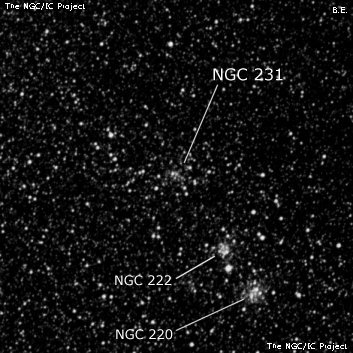
John Herschel discovered NGC 231 = h2340 on 12 Aug 1834 (sweep 482) and recorded "an irregular train of stars and nebulosity in the Nubecula Minor. (Evidently that referred to in sweep 625 [NGC 220])." His position falls very close to the cluster taken as NGC 231 (ESO 029-005 = Lindsay 25), but Corwin suggests NGC 231 really refers to the entire string of 3 clusters -[NGC 220, 222 and 231. I agree - this was his first observation here and he certainly wouldn't have picked up just the single faintest cluster but either noticed the entire string or just[NGC 220 and 222, the two brightest clusters.
Herschel suggested h2340 might be equivalent to D 2, but Dunlop likely saw only[NGC 220 or both[NGC 220 and 221, which he described as "a faint nebula, about 1.5' long, irregular figure, rather branched. This is involved in the margin of the Nubecula Minor."
Pietro Baracchi observed the cluster of 16 Dec 1887 (third of 14 objects) with the 48" Melbourne telescope and called it "eeeF, very small thin nebulosity around a minute star. Two or more stars near."
400/500mm - 18" (7/10/05 - Magellan Observatory, Australia): at 228x, this SMC cluster appeared as a moderately large, low surface brightness hazy region with an irregular outline, ~2' diameter. A few mag 14 stars were resolved. Last of three open clusters with compact NGC 222 2.5' SW and NGC 220 4.0' SW.
Notes by Steve Gottlieb